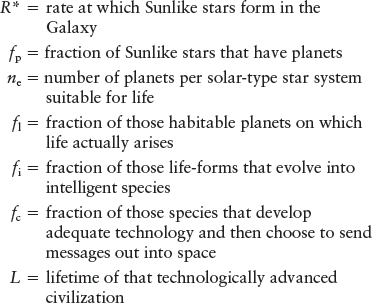15-5 The Drake equation: How many civilizations are likely to exist in the Milky Way?
Just how many planets throughout our Galaxy are likely to harbor complex life? The first person to tackle this question quantitatively was Frank Drake. He proposed that the number of technologically advanced civilizations in the Galaxy (designated by the letter N) could be estimated by what is now called the Drake equation:
N = R*fpneflfifcL
in which

Focus Question 15-4
If we detect incidental, rather than directed, signals from alien civilizations, what information might they contain?
The Drake equation expresses quantitatively the number of extraterrestrial civilizations as a product of terms, some of which can be estimated from what we know about stars and stellar evolution. For instance, thanks to new evidence for extrasolar planets, astronomers can now determine the first two terms, R* and fp, by observation. We should probably exclude stars larger than about 1.5 M⊙ because they have main-
Although low-
As “ideal” life-
478
We learned in Sections 4-
The chances that a planetary system has an Earthlike world are not yet known, although on-
Unfortunately, the rest of the factors in the Drake equation are very hypothetical. From what we know about the evolution of life on Earth, we might assume that, given appropriate conditions, the development of life is a certainty, which would make fl = 1. This value is, of course, an area of intense interest to biologists. For the sake of argument, we might also assume that evolution naturally leads to the development of intelligence (a conjecture that is hotly debated) and also make fi = 1. It is anyone’s guess as to whether these intelligent extraterrestrial beings would attempt communication with other civilizations in the Galaxy, but, if we assume they all would, fc would also be put at 1.
Focus Question 15-5
With what two numbers used in the Drake equation calculation presented previously do you disagree most? Using your numbers, how many civilizations do you estimate exist?
The last variable, L, the longevity of technological civilization, is the most uncertain of all—
N = 1 × 1 × 0.2 × 1 × 1 × 1 × 500 = 100
Therefore, out of the hundreds of billions of stars in the Galaxy, there may be only 100 civilizations technologically advanced enough to communicate with us. Of course, the numbers used here are just estimates. A wide range of values has been proposed for the terms in the Drake equation, and these various numbers produce vastly different estimates of N, the total number. Increasing the average lifetime of advanced civilizations significantly increases N. Some scientists argue that there is exactly one advanced civilization in the Galaxy and that we are it. Others speculate that there may be tens of millions of planets inhabited by intelligent creatures. Although we do not know yet, science enables us to home in on the number.